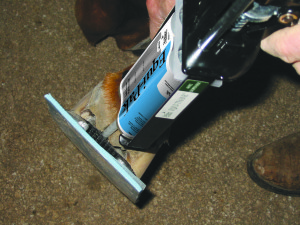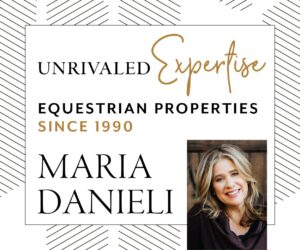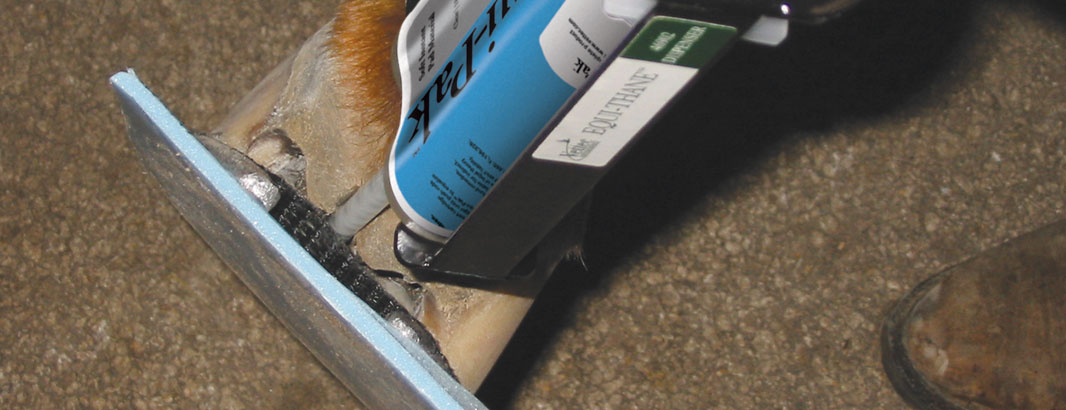The Advantages of Liquid Pad Technology to Aid Recovery
by Tab Pigg, Certified Journeyman Farrier
When an equine athlete experiences an episode of laminitis or founder it can be a painful experience. While there are numerous studies and articles on the causes of these two maladies, there is also a general consensus on what the hoof capsule experiences after the episodes occur.
When a horse experiences laminitis, whether through injury, overfeeding or metabolic issues, inflammation of the lamina occurs. The anatomy of the hoof is such that the insensitive lamina is attached to the hoof wall and the sensitive lamina is attached to the coffin bone. In the event of hoof trauma, the inflammation and reduction of blood flow can cause partial or total separation of the lamina, allowing the coffin bone to rotate downward. Laminitis can show up as subtle lameness in the front feet, external bruising in the sole or White Line Disease. When this happens, the experience can be compared to pulling off your fingernail in an accident. The relationship between the sensitive and insensitive lamina inside the hoof wall are like interlacing fingers in a tight hold; once they start to loosen, it does not take much to pull them apart. At this point it would be described as “founder.” In acute stages of founder, the hoof’s exterior would not show signs or symptoms of the disease. Once the bone has rotated, founder can be detected by an x-ray. Because the fragile attachment of the lamina is the support of the horse’s body weight, it is critical to get a hoof care team involved to address the issue fast. Proper diagnosis and treatment are crucial to recovery.
Treating Founder
Traditional methods of treating founder have varied and progressed over time. With today’s methods, in most cases an equine athlete can be expected to recover to a normal life. Past methods have included heart bar and egg bar shoes; a shoe nailed on backwards and with wedge pads. The only shoe that truly provides any type of support for a laminitic horse is a heart bar. Application of a heart bar shoe should be a very precise procedure, requiring training and x-rays for proper placement. If necessary, a vet may call for pads. In some cases, pads may allow sand and moisture to collect under the pad, which can be trapped between the pad and the foot. If the horse abscesses, the shoe will have to be removed for treatment. With any of these applications, the coffin bone and sole have limited support. Without solar or frog support, there will still be stress on the interior lamina.

When a farrier shoes the horse, all of the weight is placed on the hoof wall. When the horse moves, the coffin bone and sole are moving downward toward the ground. This creates more stress on the already inflamed lamina. The goal is to minimize stress, and support the bone column and sole. During this phase the hoof care team strives to relieve the stress between the hoof wall and the lamina. The most effective way to do that is to protect the hoof with a pad or a pour-in pad. These packages are designed to increase surface area for weight bearing so that the sole can take on some of the horse’s weight, and not just the hoof wall. Historically, it was thought that anything you put underneath a pad would help protect and cushion the sole of the horse. This, however, is not always the case. For instance traditional silicone from the hardware store has been used under a pad, despite some of its challenges. Some drawbacks of traditional silicone include: a long set time of 24 hours; messy application; the acid-base can leave a smelly residue; the material does not absorb concussions.
The best alternative to traditional pads and silicone filling is a liquid pour-in pad made of urethane adhesive. Products like Vettec’s Equi-Pak offer a versatile solution that is easy to apply, sets quickly and produces a soft, resilient supportive pad material. Advantages of pour-in pad materials include: an immediate bond to the sole, sealing out moisture, etc.; the pour-in pad material can be filled to ground level for maximum support and effectively absorbs concussion. It also offers support to the boney column by loading the entire solar surface and positioning the weight-bearing load over the entire ground surface and not just the wall. This reduces the “pull” on the lamina between the hoof wall and internal structures resulting in a faster recovery and a more comfortable horse.

Modern liquid pad materials come in different levels of firmness so they will match the needs of the individual horse. The pad materials can be poured to ground level. Even on hard ground, the sole frog and hoof wall bear equal weight. The pads can be customized so that if you do not want to cover an area that may be sensitive, it can be blocked out. Even if the whole sole cannot be covered, a half pad is 50% more support than not having any.
Conclusion
Managing a horse’s acute founder or laminitis can be a challenge, and it’s important to have a good team in place to diagnose, manage the treatment and ensure recovery of the equine athlete. There are a number of treatments on the market today, but consider ones that will help relieve the internal stresses within the hoof capsule and support the boney column, providing a speedier recovery and a more comfortable horse. Using liquid pad technology, veterinarians and farriers now have the ability to use materials that will bond to the foot and withstand the weight of the horse.
Tab Pigg is a Certified Journeyman Farrier and Farrier-at-Large for Vettec Inc., a manufacturer of innovative sole support products for horses. In his role at Vettec, Tab leads hands-on clinics throughout the U.S. to teach shoeing and forging techniques to equine owners, farriers, and veterinarians. He also visits veterinary and farrier schools exchanging information about hoof anatomy and shoeing. Tab shares his expertise via a popular video and blog series,“Two Minutes with Tab” on Vettec.com For Tab, shoeing horses is much more than a way to earn a paycheck. Helping horses and knowing that he has the ability to improve the horse’s quality of life is very valuable to him. Tab lives his own motto every day: “The education to become a farrier never ends. Anyone who feels that they have it all figured out is wrong.”






